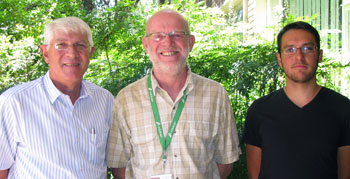
Pictured from the left are: Prof Zakkie Pretorius, Dr Botma Visser and Howard Castelyn.
Photo: Supplied |
In his research, Dr Botma Visser, researcher in the Department of Plant Sciences at the University of the Free State, highlighted the population dynamics of the stem rust fungus (Puccinia graminis f. sp. tritici) in Southern Africa. In recent years, two foreign stem rust races were introduced to South Africa, and a local virulence adaptation occurred in a third.
All of these races form part of the Ug99 group, a highly virulent collection of rust races endangering wheat production in many parts of the world. Despite the fact that half of the members of the Ug99 race group is prevalent in South Africa, Dr Visser’s work has clearly shown that Ug99 did not have its origin here. This emphasised the need to include neighbouring countries in the annual stem rust surveys, to proactively identify new races that could threaten local wheat production. In his research, Dr Visser also mentioned the way in which he has optimised modern molecular tools to accurately detect Ug99 isolates.
Dr Visser is one of three scientists from the Department of Plant Sciences that addressed delegates attending the biennial congress of the Southern African Society for Plant Pathology (SASPP) on the Bloemfontein Campus earlier this month on progress regarding research on wheat rust diseases conducted at the UFS.
Howard Castelyn, a PhD student in Plant Sciences, presented his research on quantifying fungal growth of the stem rust pathogen in wheat varieties displaying genetic resistance. This resistance, which is best expressed in adult plants, has the potential to remain durable in the presence of new rust variants. His presentation at the congress focused on optimising microscopic and molecular techniques to track fungal development in stem tissues of adult plants. These results now allow scientists to link rust infection levels and cellular responses with particular resistance genes expressed by the wheat plant, and contributing to the understanding and exploitation of durable resistance.
Prof Zakkie Pretorius presented his research, explaining how new genetic diversity for resistance to the stripe (yellow) rust fungus (Puccinia striiformis) is discovered, analysed and applied in South Africa. This research, conducted in collaboration with Dr Renée Prins and her team at CenGen, is unravelling the genetic basis of stripe rust resistance in a promising wheat line identified by Dr Willem Boshoff, a plant breeder at Pannar. The line and DNA markers to track the resistance genes will soon be introduced to South African wheat breeding programmes.
The rust research programme at the UFS contributes significantly to the successful control of these important crop diseases.
In addition to the contributions by the UFS, rust fungi featured prominently at the SASPP, with first reports of new diseases on sugar cane and Acacia and Eucalyptus trees in South Africa. A case study of the use of a rust fungus as a biological control agent for invasive plant species in the Western Cape, was also presented.
For more information or enquiries contact news@ufs.ac.za .